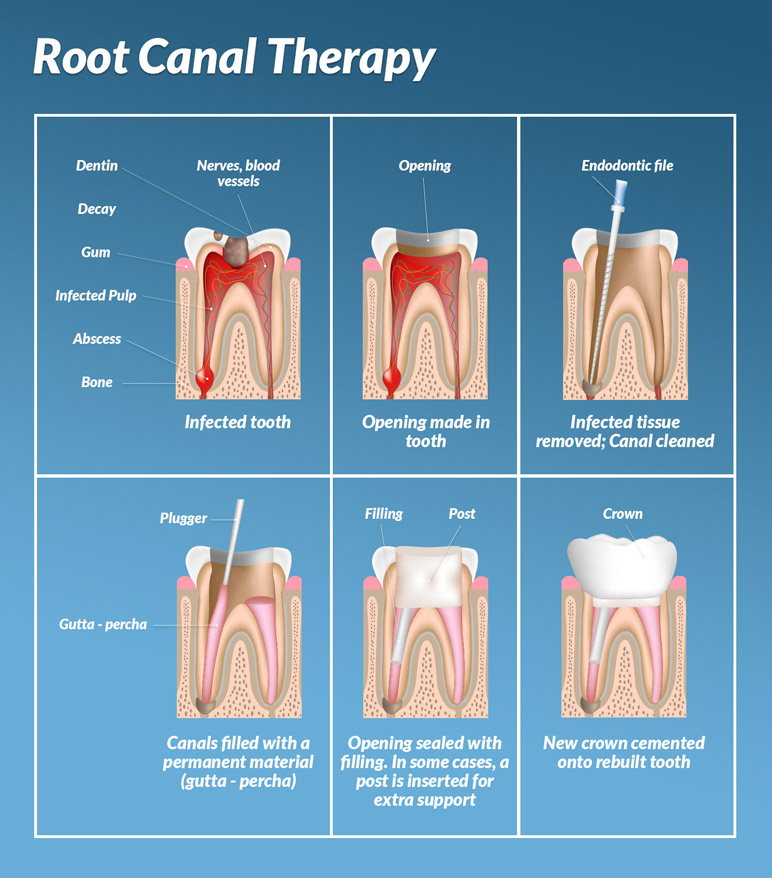
Endodontic treatment can take one to two weeks as at least two appointments are required to complete the procedure. Before starting root canal therapy, your dentist will discuss the surgery, explain the risks and any concerns you may have. Talk to Dr Wilcox or Dr Cooke about any concerns you have and the options available to you.

There are four parts to root canal therapy:
Preparation
To ensure your comfort during the procedure, your dentist will discuss the anaesthetic options with you. In most cases you will be sedated using local anaesthetic and nitrous oxide (happy gas), which completely numbs the area around the tooth before any treatment begins.
Once your tooth and surrounding gums are completely numbed, a dental dam is place over the tooth and surrounding area to sterilize and prevent saliva from entering the area where the dentist will be working. The tooth that needs work will protrude through a hole punched in the dental dam, isolating it from the rest of your mouth. Your dentist will take an x-ray and measure the depth of the canal to ensure the whole cavity is thoroughly cleaned out.
Cleaning the root canal
In order to access the pulp chamber and root canals, your dentist will use specialised tools to drill a small hole through the top of the tooth. Once access is gained, all of the tooth canals and chamber are completely cleaned of dead or dying tissue and nerves. This is done using fine instruments called endodontic files, similar to wire brushes, and should be completely pain free thanks to the sedation.
When the pulp and nerves are removed, the tooth itself can no longer feel any pain. To prevent the problem from repeating, the inside of the tooth is flushed with disinfectant and antibacterial wash to remove any excess bacteria. The final step to cleaning is to dress the canals with an antibacterial solution before covering the tooth with a temporary seal to protect it before the permanent filling can be fitted. Depending on the fragility of your tooth, your dentist may need to fit a metal band around the tooth to prevent it from fracturing while the tooth is hollow.
Follow these steps to care for your tooth after the first procedure:
 Avoid eating until the anaesthetic has worn off or you may damage your mouth without realising
Avoid eating until the anaesthetic has worn off or you may damage your mouth without realising Avoid chewing in the area of your mouth where the treated tooth is until the treatment is completed (tooth sealed and a new crown fitted)
Avoid chewing in the area of your mouth where the treated tooth is until the treatment is completed (tooth sealed and a new crown fitted) Brush and floss your teeth regularly as you normally would
Brush and floss your teeth regularly as you normally would The temporary filling may wear down before your second appointment. If you believe it has completely dissolved, contact your dentist immediately
The temporary filling may wear down before your second appointment. If you believe it has completely dissolved, contact your dentist immediatelyFilling the root canal
At your second appointment, your tooth is uncovered and once again flushed with an antibacterial wash. A rubber-like material called gutta-percha is then filled into the root canal tightly to seal them. If your dentist is concerned about the strength of your tooth, a metal or strong plastic support post may be inserted into one of the root canals to stabilise the tooth.
When the procedure is complete, a filling material will be placed to seal the access hole. In some cases your dentist may recommended a crown be placed over the top of the tooth to protect and strengthen it. This prevents fractures and keeps bacteria out.
Post treatment pain management
Following your root canal treatment you will need to take precautions to ensure your tooth heals properly from the procedure. If infection or an abscess were present, your dentist may prescribe antibiotics to treat and prevent further infection. It is normal to experience minor discomfort for a few days following the treatment, and this can usually be treated with over the counter painkillers such as ibuprofen and paracetamol. You will be required to visit your dentist for regular checkups and x-rays following the treatment, to ensure there is no sign of infection in or around the tooth.



